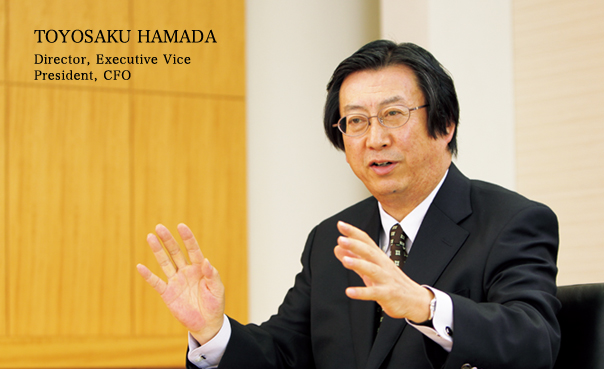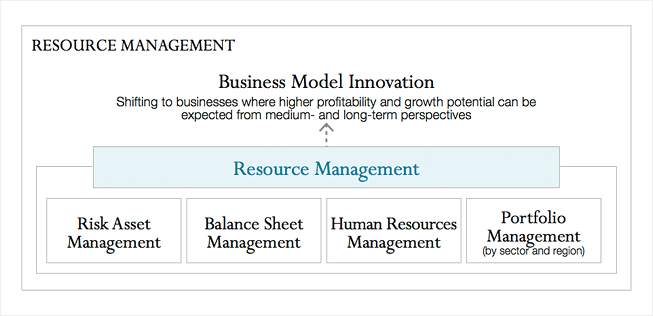Special Feature 2 Management Stability: Risk Management Designed to Accelerate Earnings Expansion
Question 1 What are your views on ensuring management stability, Mr. Hamada?
 I believe that ensuring stable management means creating conditions for the company's management policies to be shared by all officers and employees, without any inconsistency, thereby allowing personnel to focus on their duties. To achieve this goal, a company must have a knowledgeable and assertive management team, a system for developing talented employees, a reliable risk management system and a strong financial position. I believe that an operating base capable of sustained growth is only possible when all of these elements come together.
I believe that ensuring stable management means creating conditions for the company's management policies to be shared by all officers and employees, without any inconsistency, thereby allowing personnel to focus on their duties. To achieve this goal, a company must have a knowledgeable and assertive management team, a system for developing talented employees, a reliable risk management system and a strong financial position. I believe that an operating base capable of sustained growth is only possible when all of these elements come together.
I am responsible for supervising the risk management system. To explain this concept, let me begin by noting that Sumitomo Corporation positions risk management at the highest level of business management. It is seen as a basic tool for maximizing corporate value, not merely as an individual element. Generating a return by taking risk is a fundamental business concept. Because a general trading company's businesses span a diverse array of fields and regions, these companies are exposed to many different risks indeed. How to handle this risk poses an extremely difficult problem. Nonetheless, the degree of skill with which risk is managed will have a significant bearing on the creation of sustainable corporate value.
From an early stage, Sumitomo Corporation has incorporated risk management deeply into business management. Thereafter, Sumitomo Corporation has worked to raise the sophistication of its risk management system according to changes in the business environment. One example was the introduction of the Risk-adjusted Return Ratio* ahead of other companies. This Company-wide benchmark looks at profitability in terms of how much return is generated relative to the risk taken. (Please click here for details on risk management.)
Another key factor is a strong financial position. We believe that it is crucial to ensure financial soundness, taking into account such factors as the possible destabilization of financial market conditions as result of the European debt crisis. By financial soundness, we mean reinforcing a system for ensuring access to low-cost, long-term funding by securing prime fundraising sources. This also entails maintaining adequate liquidity in hand, such as cash and deposits and committed lines, in readiness for possible refinancing risks.
I believe that stable management is possible only when all of these elements have been established effectively. Management stability, in turn, lays the groundwork for future earnings expansion.
*Risk-adjusted Return Ratio = Net income/Risk-adjusted assets (maximum possible losses)
The Risk-adjusted Return Ratio is a benchmark that looks at profitability in terms of how much return is generated relative to a given amount of risk. Specifically, risk assets, or the maximum possible losses, are measured by multiplying asset values by a risk weight representing the maximum possible rate of decline in the value of each type of asset.
Question 2 Could you please explain specific risk management measures you have implemented under the medium-term management plan ƒ(x), in light of changes in the business environment?

The business environment surrounding Sumitomo Corporation has changed drastically. To illustrate, as the focus of economic growth shifts from the developed world to emerging countries, burgeoning demand for infrastructure and food, among other items, is anticipated in emerging countries going forward. Also, the restructuring of industry in Japan and full-fledged moves by Japanese companies to expand operations offshore are anticipated in step with change in the industrial structure. Sumitomo Corporation's business opportunities will also change in line with these developments in the external environment. Accordingly, under the ƒ(x) plan, we have promoted business model innovation in response to the demands of the times.
In light of current and future conditions, emerging countries have a relatively higher growth potential than developed nations. I believe that emerging countries present two main types of business opportunities. The first is business opportunities arising from emerging countries' role as a production and export base providing various resources and manufactured goods to consumers in other nations. The second is business opportunities spawned by internal demand against the backdrop of high economic growth rates and expanding populations. On the other hand, business expansion in emerging countries will lead to a significantly higher exposure to various risks including country risk.
Although emerging countries present various business opportunities, given that Sumitomo Corporation has only finite business resources, we must make investment decisions based on metrics such as the Risk-adjusted Return Ratio, ROA and the Internal Rate of Return (IRR). However, no matter how high the expected return, if we excessively concentrate our business resources on specific businesses in emerging countries, we may incur huge losses in the event that risks materialize. Therefore, portfolio management has taken on increasing importance from the standpoint of determining how to avoid excessive concentrations of business resources in a specific sector or region. We have maintained a balanced portfolio in terms of sectors and regions.
Another important factor is balance sheet management. Our balance sheet is managed from the perspectives of ensuring liquidity, a proper debt-equity ratio (DER) and the amount of total assets, while taking into account financial market conditions at each point in time. At present, we must also consider factors such as the possible destabilization of the financial system as a result of the long-term entrenchment of the European debt crisis. Accordingly, Sumitomo Corporation has secured a high level of liquidity. We hold cash and deposits of more than ¥800 billion, which equates to around one-ninth of consolidated total assets of approximately ¥7,200 billion, and committed lines which enable us to raise funds in times of urgency.
We also believe that it is important to enhance shareholders' equity by recording net income in line with the management plan, while implementing risk asset management by keeping risk assets within shareholders' equity.
For the foregoing reasons, we believe that risk asset management, portfolio management and balance sheet management are particularly important themes under the ƒ(x) plan. One of the plan's key actions is to “accelerate strategic resource management,” which includes these themes as well as human resources management.
Question 3 Could you please share your perspectives on what will be necessary to maintain stable management going forward?
 Sumitomo Corporation sees risk management as a basic tool for sustaining stable management. I believe that our business segments are able to accelerate business projects knowing that they are backed by an outstanding risk management system. In this sense, I believe that it is crucial to keep the fundamental approach and framework to our risk management system unchanged. At the same time, we must allow the system to evolve in sophistication in line with changes in the business environment and management stage and to provide us the flexibility of prioritizing our risk management methods.
Sumitomo Corporation sees risk management as a basic tool for sustaining stable management. I believe that our business segments are able to accelerate business projects knowing that they are backed by an outstanding risk management system. In this sense, I believe that it is crucial to keep the fundamental approach and framework to our risk management system unchanged. At the same time, we must allow the system to evolve in sophistication in line with changes in the business environment and management stage and to provide us the flexibility of prioritizing our risk management methods.
In my role as CFO, I will continue to tirelessly strive as before to develop an optimal portfolio that closely fits our fund procurement structure. Since fund procurement is subject to a certain degree of constraint, we will press ahead with the replacement of assets in line with our resource management policy, while remaining within our fund procurement limit. The “strategy conference” is currently held among CEO and general managers of each unit once every three months. Here, I strive to listen closely to the voice of the business unit side. At the same time, as the manager of the liabilities side of the balance sheet, I work to ensure proper communication by conveying various matters, such as “although we would like to execute as much as possible, the Company does have limitations.”
In closing, I would like to say a few words about prioritizing our risk management methods going forward. Under the current ƒ(x) plan, we are focusing on strategic resource management. However, I believe that our next theme will be cash flow management. Cash flow management entails proactively controlling cash flow in line with company policies and strategies. I believe that the ability to generate cash according to business plans will take on the greatest importance in the years ahead.
